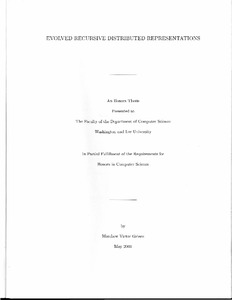| dc.rights.license | In Copyright | en_US |
| dc.creator | Grieco, Matthew Victor | |
| dc.date.accessioned | 2023-10-20T18:01:26Z | |
| dc.date.available | 2023-10-20T18:01:26Z | |
| dc.date.created | 2003 | |
| dc.identifier | WLURG038_Grieco_thesis_2003 | |
| dc.identifier.uri | https://dspace.wlu.edu/handle/11021/36518 | |
| dc.description.abstract | Computer Science has become increasingly biologically inspired, with neural networks and evolutionary computing gaining increased prominence in the field. Recently, several difficulties
with modeling connectionist networks and using genetic algorithms to train neural networks were resolved ( or at least the topic of several studies). These problems included how
to create a connectionist model that could represent variable-sized recursive data structures in fixed-width patterns and how genetic algorithms were used to evolve neural networks.
However, no coherent union of these problems has been made. The purpose of this study is to compare Back-Propagation, the classic way to train connectionist networks, to those
Genetic Algorithms used for evolving weight dynamics, a novel way to train connectionist networks on a Recursive Auto-Associative Memory (RAAM) neural network architecture.
The ability of a Genetic Algorithm to train a RAAM network is tested through two different problems. The first comparison is made through a simple auto-association problem where
the fitness of networks trained by Genetic Algorithm's is compared with the fitness of networks trained by back-propagation. Since back-propagation has already been established
to create RAAM networks that can solve novel tasks, it is used here as a benchmark with which to compare RAAM architectures created with evolutionary techniques. Secondly, a
Pursuer/Evader Game is played by RAAM networks trained with a genetic algorithm. The results show that Genetic Algorithms are an effective method to examine the complexity
found in a RAAM network. | en_US |
| dc.format.extent | 34 pages | en_US |
| dc.language.iso | en_US | en_US |
| dc.rights | This material is made available for use in research, teaching, and private study, pursuant to U.S. Copyright law. The user assumes full responsibility for any use of the materials, including but not limited to, infringement of copyright and publication rights of reproduced materials. Any materials used should be fully credited with the source. | en_US |
| dc.rights.uri | http://rightsstatements.org/vocab/InC/1.0/ | en_US |
| dc.subject.other | Washington and Lee University -- Honors in Computer Science | en_US |
| dc.title | Evolved Recursive Distributed Representations | en_US |
| dc.type | Text | en_US |
| dcterms.isPartOf | WLURG038 - Student Papers | en_US |
| dc.rights.holder | Grieco, Matthew Victor | en_US |
| dc.subject.fast | Genetic algorithms | en_US |
| dc.subject.fast | Back propagation (Artificial intelligence) | en_US |
| dc.subject.fast | Neural networks (computer science) | en_US |
| local.department | Computer Science | en_US |
